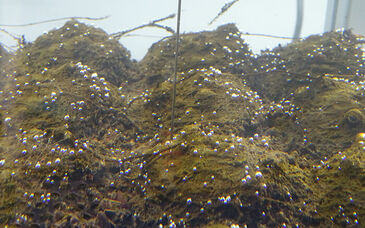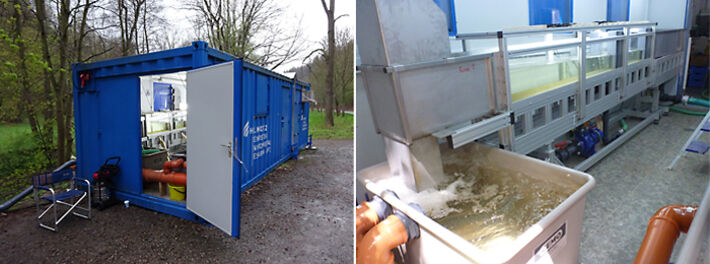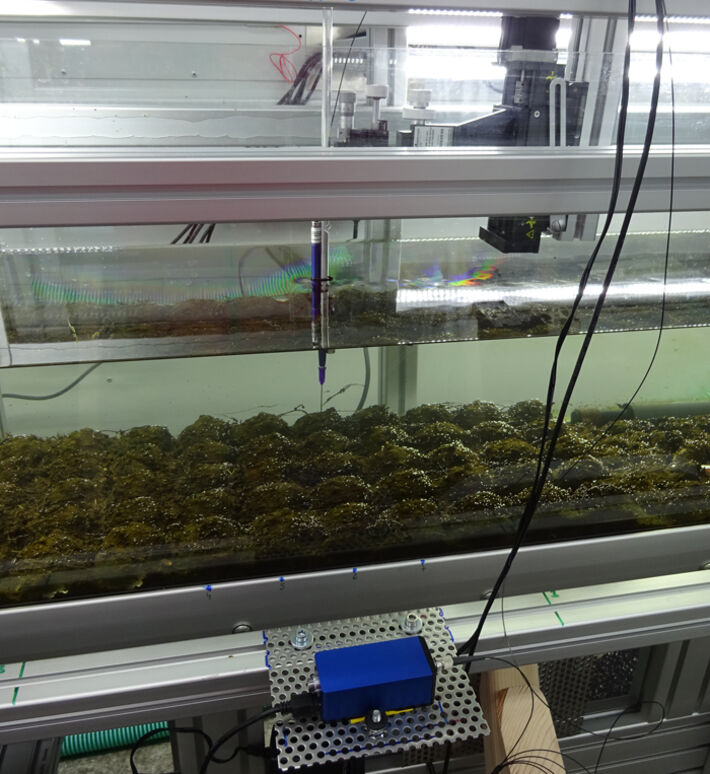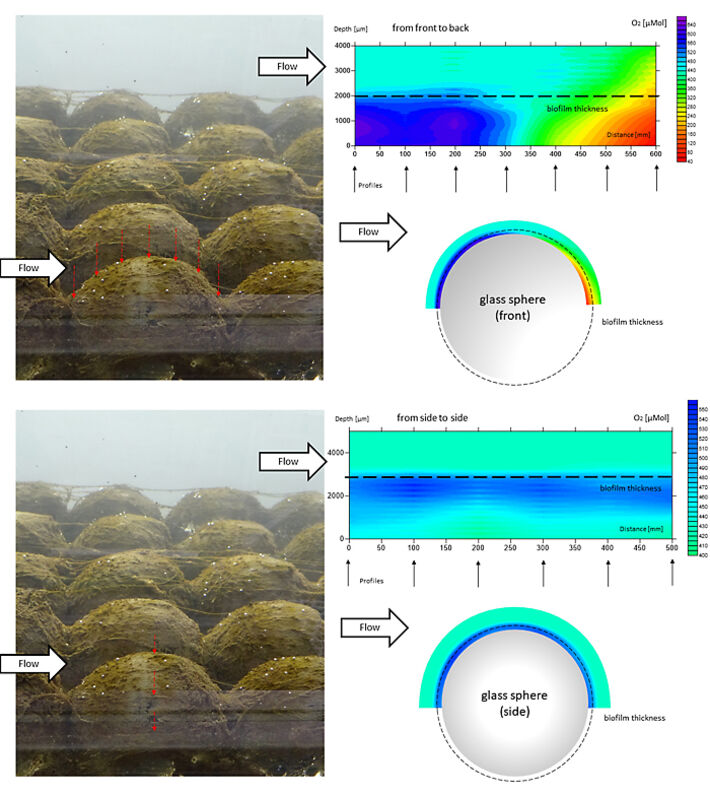Watch tutorials, webinars and informative videos about PreSens optical sensor systems.
High Resolution O2 Microprofiling of a Freshwater Stream Biofilm
Use of an Automated Micromanipulator System and O2 Microsensors in a Flume Experiment
Christine Anlanger1,2, Ute Risse-Buhl1, Kaan Koca1,2, Christian Noss2, Andreas Lorke2, Markus Weitere1, Martin S. Gutbrod3
1Department River Ecology, Helmholtz Centre for Environmental Research - UFZ, Magdeburg, Germany
2Institute for Environmental Sciences, Environmental Physics, University of Koblenz-Landau, Landau, Germany
3PreSens Precision Sensing GmbH, Regensburg, Germany
The objective of this study was to determine oxygen fluxes and the spatial micro-heterogeneity of microbial respiration and photosynthesis of a stream biofilm from the Selke stream, Harz Mountains. For this purpose, we used PreSens fiber optic O2 microsensors and an Automated Micromanipulator system to record O2 micro-gradients within the biofilm and overlaying water in 100 µm resolution. The results were related to mean flow and turbulence conditions above the biofilm and showed strong variations in relation to the flow field.
Microbial biofilms constitute an integral part of all aquatic ecosystems and strongly contribute to their O2 budget due to their large surface area. Mountainous stream biofilms are controlled by manifold factors such as light, nutrients, grazing or their spatially highly variable hydrodynamics. Consequently, hydrodynamics become a dominant factor shaping biofilms through drag forces [1, 2] and control the supply of nutrient resources through mass transfer processes [3]. The extent of the diffusion boundary layer (DBL) is directly affected by the turbulence intensities in the turbulent boundary layer and controls transport processes and uptake efficiency of biofilms. An important challenge, as technical difficult to realize, remains in establishing links between habitat heterogeneity generated by flow hydrodynamics, and the metabolic biofilm response on the micro-scale level. In this study, we measured micro-scale O2 fluxes and O2 micro-distributions in a freshwater biofilm and their diffusive boundary layers within a stream-side flume fed by stream water of the Selke (Harz Mountains, Saxony-Anhalt). The objective of this study was to determine oxygen fluxes and spatial micro-heterogeneity of microbial respiration and photosynthesis and relate these results to the micro-hydrodynamics.
Materials & Methods
Experiments were performed in a flume (length x width x depth = 5.2 x 0.3 x 0.5 m) installed inside a 'mobile aquatic mesocosm' (MOBICOS, [4]) located at the Selke stream (Harz Mountains, Saxony-Anhalt, Germany, Fig. 1). The flume was equipped with inert glass beads of different sizes (diameter of 2, 4, and 6 cm) to mimic natural habitat heterogeneity and turbulence intensities and received stream water and thus suspended microbial communities and nutrients from the Selke. The water depth was approximately 0.2 m and mean flow velocity approximately 0.2 m/s. Biofilms were cultivated for 4 weeks under constant flow conditions and near natural photosynthetic active radiation for 10 hours per day. O2 microprofiling was performed with PreSens Profiling Microsensors (PM-PSt7), an OXY-1 ST micro fiber optic oxygen meter and the Automated Micromanipulator (AM) system with 1 µm resolution (Fig. 2). Biofilms covering glass beads were profiled in longitudinal and transversal main flow direction in 1 cm intervals. Microprofiles were recorded along the z-axis through the overlaying water and into the biofilm in 100 µm steps (Fig. 3). The flow and turbulence above biofilms were characterized by means of a 3D acoustic Doppler velocity ADV profiler (Vectrino II, Nortek AS, Norway) as a spot measurement and by a custom-made particle image velocimetry PIV system for the 2D spatial distribution of the flow field.
Results of Oxygen Profiling
The results show a clear separation into a hyperoxic and hypoxic zone in a front to back direction along the flow field of the glass beads. O2 supersaturated conditions of up to 146 % (645 µM) were recorded at the very front of the glass beads, while the back exhibited saturation states as low as 11 % (47 µM) of the overall stream saturation. The lateral transect of the glass bead exhibited a more uniform distribution with increased oxygen evolution in the first mm of the biofilm, up to 565 µM. The diffusive boundary layer thicknesses were measured to vary between 200 - 1200 µm from front to back of the flow field and laterally between 400 / 600 µm along the transects. The results are consistent with a higher colonization of phototrophs along the upstream side of the bead where increased shear is apparent compared to less colonized and higher detritus aggregation on the lee side of the bead characterized by a recirculation cell which occupies the space between subsequent beads (Fig. 3). The formation of gas bubbles, which proved to be of the same O2 saturation state as the biofilm, at supersaturated locations on top of the biofilm was also observed.
Conclusion
The results showed that O2 micro-gradients and diffusive boundary layers down to 200 µm could be detected with PreSens Profiling Microsensors and the Automated Micromanipulator. The micro-invasive nature of the measurement technique allowed for fine-scale measurements on the micro-level, without the need for extensive sample preparation or fixation. The profiling equipment was therefore an indispensable tool in our long-term monitoring experiments that necessitated continuous analytical, hydrodynamic as well as molecular sampling of a highly dynamic ecological system.
References:
[1] Biggs, B. J. F. & Thomsen, H. A. (1995). Disturbance of stream periphyton by perturbations in shear stress: time to structural failure and differences in community resistance. Journal of Phycology, 31 (2), 233 - 241
[2] Battin, T. J., Kaplan, L. A., Newbold, J. D. Cheng, X. & Hansen, C. (2003). Effects of Current Velocity on the Nascent Architecture of Stream Microbial Biofilms. Applied and Environmental Microbiology, 69 (9), 5443 - 5452
[3] Battin, T. J., Sloan, W. T., Kjelleberg, S., Daims, H., Head, I. M., Curtis, T. P. & Eberl, L. (2007). Microbial landscapes: new paths to biofilm research. Nature Reviews Microbiology, 5 (1), 76 - 81
[4] Wollschläger, U., Attinger, S., Borchardt, D., Brauns, M., Cuntz, M. Dietrich, P., Zacharias, S. (2017). The Bode hydrological observatory: a platform for integrated, interdisciplinary hydro-ecological research within the TERENO Harz / Central German Lowland Observatory. Environmental Earth Sciences, 76 (1)






